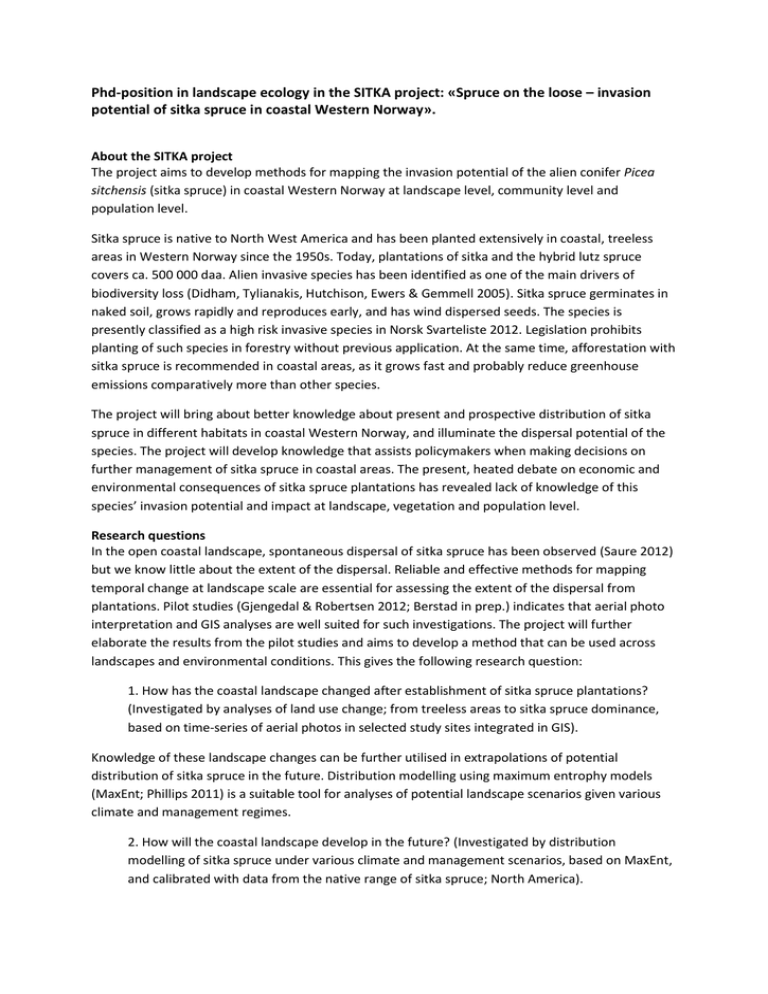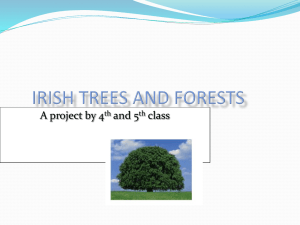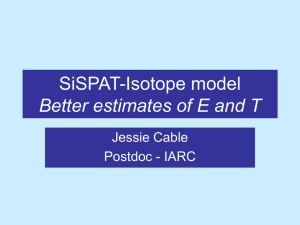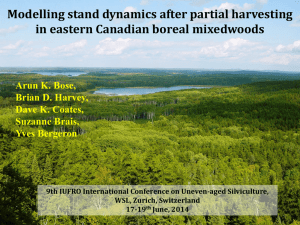Phd-position in landscape ecology in the SITKA project: «Spruce on
advertisement

Phd-position in landscape ecology in the SITKA project: «Spruce on the loose – invasion potential of sitka spruce in coastal Western Norway». About the SITKA project The project aims to develop methods for mapping the invasion potential of the alien conifer Picea sitchensis (sitka spruce) in coastal Western Norway at landscape level, community level and population level. Sitka spruce is native to North West America and has been planted extensively in coastal, treeless areas in Western Norway since the 1950s. Today, plantations of sitka and the hybrid lutz spruce covers ca. 500 000 daa. Alien invasive species has been identified as one of the main drivers of biodiversity loss (Didham, Tylianakis, Hutchison, Ewers & Gemmell 2005). Sitka spruce germinates in naked soil, grows rapidly and reproduces early, and has wind dispersed seeds. The species is presently classified as a high risk invasive species in Norsk Svarteliste 2012. Legislation prohibits planting of such species in forestry without previous application. At the same time, afforestation with sitka spruce is recommended in coastal areas, as it grows fast and probably reduce greenhouse emissions comparatively more than other species. The project will bring about better knowledge about present and prospective distribution of sitka spruce in different habitats in coastal Western Norway, and illuminate the dispersal potential of the species. The project will develop knowledge that assists policymakers when making decisions on further management of sitka spruce in coastal areas. The present, heated debate on economic and environmental consequences of sitka spruce plantations has revealed lack of knowledge of this species’ invasion potential and impact at landscape, vegetation and population level. Research questions In the open coastal landscape, spontaneous dispersal of sitka spruce has been observed (Saure 2012) but we know little about the extent of the dispersal. Reliable and effective methods for mapping temporal change at landscape scale are essential for assessing the extent of the dispersal from plantations. Pilot studies (Gjengedal & Robertsen 2012; Berstad in prep.) indicates that aerial photo interpretation and GIS analyses are well suited for such investigations. The project will further elaborate the results from the pilot studies and aims to develop a method that can be used across landscapes and environmental conditions. This gives the following research question: 1. How has the coastal landscape changed after establishment of sitka spruce plantations? (Investigated by analyses of land use change; from treeless areas to sitka spruce dominance, based on time-series of aerial photos in selected study sites integrated in GIS). Knowledge of these landscape changes can be further utilised in extrapolations of potential distribution of sitka spruce in the future. Distribution modelling using maximum entrophy models (MaxEnt; Phillips 2011) is a suitable tool for analyses of potential landscape scenarios given various climate and management regimes. 2. How will the coastal landscape develop in the future? (Investigated by distribution modelling of sitka spruce under various climate and management scenarios, based on MaxEnt, and calibrated with data from the native range of sitka spruce; North America). A closer look at the dispersal of sitka spruce in the open coastal landscape reveals a distinct variation in the nature types’ invasibilities. Open treeless areas such as coastal heathland, bogs and fens and encroached semi-natural grasslands are particularly prone to such invasion (Saure, Vandvik, Hassel & Vetaas 2013). Analyses of how sitka spruce invasion relates to underlying environmental factors (moisture, soil depth, soil chemical factors, local climate, etc.) in different vegetation types will increase the understanding of the invasion process at community level. Vegetation ecological investigations and multivariate analyses may illuminate these questions. 3. What is the sitka spruce invasion potential of coastal, treeless habitats? (Investigated by vegetation analysis and multivariate methods to reveal the relation between vegetation, ecological factors and sitka spruce invasion level). The changes we observe at landscape and community level reflect how individual sitka spruce plants and populations respond to environmental factors, in particular how the dispersal ability of the species is affected. In the project, individual sitka spruce plants growing under various environmental conditions will be tracked over time to achieve data for use in population modelling, using methods such integrated population modelling (IPM; Merow, Smith, Edwards, Guisan, McMahon et al. 2014). 4. How does sitka spruce demography relate to invasion success? (Investigated by IPM to reveal how invasion success in various habitats relates to population growth rate, dispersal potential in space and time and germination and establishment success). Organisation This is a three years position that may be extended with a fourth compulsory year of duty at Faculty of Engineering and Science (AIN) at Sogn og Fjordane University College (HiSF). The candidate will be formally affiliated to University of Oslo (UiO). The GEco group at UiO (http://www.nhm.uio.no/english/research/groups/geco/) represents important cooperation partners. The place of work will be at HiSF in Sogndal, and the project includes field work in Western Norway. The candidate will be a part of a larger phd-group at AIN (mainly related to the NFR project RELEASE) and cooperate with the restoration ecology group at the department (lenke til nettside?). Bachelor and master projects may be related to the project. Towards the end of the project, the candidate can spend three months at Radboud Universiteit, Nijmegen, the Netherlands. References Didham, R.K., Tylianakis, J.M., Hutchison, M.A., Ewers, R.M., & Gemmell, N.J. (2005). Are invasive species the drivers of ecological change? Trends in Ecology and Evolution, 20, 470-474. Gjengedal, M., & Robertsen, H. (2012). Landskapsendringer som følge av planting og spredning av sitkagran. Sogndal (unpubl.): Bachelor thesis, AIN, HiSF. Merow, C., Smith, M.J., Edwards, T.C., Guisan, A., McMahon, S.M., Normand, S., Thuiller, W., Wüest, R.O., Zimmermann, N.E., & Elith, J. (2014). What do we gain from simplicity versus complexity in species distribution models? Ecography, 5, 99-110. Phillips, S. (2011). A brief tutorial on Maxent. At & T Research, Princeton, NJ. Saure, H.I. (2012). Impact of native and introduced coniferous species on biodiversity in semi-natural coastal vegetation, western Norway. Bergen: PhD Thesis, Department of Biology, University of Bergen. Saure, H.I., Vandvik, V., Hassel, K., & Vetaas, O.R. (2013). Effects of invasion by introduced versus native conifers on coastal heathland vegetation. Journal of Vegetation Science, 24, 744-754.









